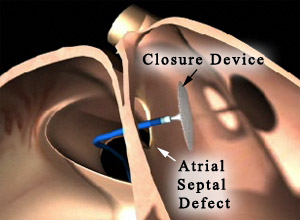
Individuals born with
Structural Heart Disease may have defects or "holes" in the heart that lead to potentially harmful alterations in blood flow. A hole in the heart's atrial septum (the tissue membrane that divides the left and right atrial chambers) is termed an
atrial septal defect (ASD). ASDs are present in approximately 4 out of every 100,000 newborns, and if left untreated, can result in increased pressures within cardiac chambers, lead to symptoms of heart failure, and in certain instances cause severe elevation in pulmonary (lung) artery pressure. ASDs may be diagnosed by echocardiography after a routine physical exam reveals a heart murmur.
ASDs may be treated by undergoing open heart surgery, but certain defects can be closed percutaneously (less invasively by a heart catheterization procedure performed through a catheter in the leg). BCS Heart offers percutaneous ASD closure to those patients who will benefit.
Much more common than an ASD is a congenital cardiac lesion persistent into adulthood called a patent foramen ovale (PFO). In simplistic terms, a PFO is the result of incomplete closure of atrial tissue, whereas an ASD is the result of complete absence of such tissue between the right and left atrial heart chambers. PFOs tend to be substantially smaller holes than ASDs, are very common, and are present in one out of four people. In most people, PFOs remain asymptomatic, and nothing is required for their treatment. However, in patients with stroke of unknown cause, especially younger patients with stroke less than 55 years of age, PFOs are found with increased prevalence, suggesting a causative role. A parodoxical embolism ("blood clot") passing from the right heart to the left heart through the PFO opening can be transported to the brain, resulting in a debilitating stroke. Closure of PFOs may also benefit patients with severe migraine/vascular headache, scuba divers suffering from decompression sickness and air embolism, or patients with a rare condition known as platypnea-orthodeoxia syndrome. When indicated, BCS Heart offers percutaneous PFO closure to those patients who will benefit.

Following patient sedation, usually in an operating room or similar setting, a catheter is inserted through the leg/groin and positioned across the hole in the patient's heart. A closure device (see figure to the right showing an Amplatzer Septal Occluder) is then deployed which resembles a small "plug" covering the hole. The heart will then heal around the plug over the ensuing months until no hole remains and the lesion is fixed. Recovery from the percutaneous procedure is rapid and patients usually can return home the same or following day.
For additional information regarding ASD and PFO closure please ask your doctor at BCS Heart.

 Individuals born with Structural Heart Disease may have defects or "holes" in the heart that lead to potentially harmful alterations in blood flow. A hole in the heart's atrial septum (the tissue membrane that divides the left and right atrial chambers) is termed an atrial septal defect (ASD). ASDs are present in approximately 4 out of every 100,000 newborns, and if left untreated, can result in increased pressures within cardiac chambers, lead to symptoms of heart failure, and in certain instances cause severe elevation in pulmonary (lung) artery pressure. ASDs may be diagnosed by echocardiography after a routine physical exam reveals a heart murmur.
Individuals born with Structural Heart Disease may have defects or "holes" in the heart that lead to potentially harmful alterations in blood flow. A hole in the heart's atrial septum (the tissue membrane that divides the left and right atrial chambers) is termed an atrial septal defect (ASD). ASDs are present in approximately 4 out of every 100,000 newborns, and if left untreated, can result in increased pressures within cardiac chambers, lead to symptoms of heart failure, and in certain instances cause severe elevation in pulmonary (lung) artery pressure. ASDs may be diagnosed by echocardiography after a routine physical exam reveals a heart murmur.
 Following patient sedation, usually in an operating room or similar setting, a catheter is inserted through the leg/groin and positioned across the hole in the patient's heart. A closure device (see figure to the right showing an Amplatzer Septal Occluder) is then deployed which resembles a small "plug" covering the hole. The heart will then heal around the plug over the ensuing months until no hole remains and the lesion is fixed. Recovery from the percutaneous procedure is rapid and patients usually can return home the same or following day.
Following patient sedation, usually in an operating room or similar setting, a catheter is inserted through the leg/groin and positioned across the hole in the patient's heart. A closure device (see figure to the right showing an Amplatzer Septal Occluder) is then deployed which resembles a small "plug" covering the hole. The heart will then heal around the plug over the ensuing months until no hole remains and the lesion is fixed. Recovery from the percutaneous procedure is rapid and patients usually can return home the same or following day.